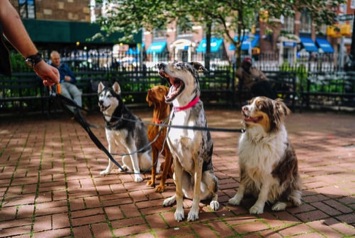But if his negative glass ends up being fuller, or his glasses remain empty as in lack of socialization, he will display anxiety, fear, defensive aggression, avoidance, escape, redirected aggression, and depression.
This learning by association teaches a dog whether a person, situation or context predicts something good or whether it predicts something bad or scary, and the dog will then act accordingly.
By the way, this process works the same for us. We are constantly making positive or negative associations as well.
Therefore it is important that we fill up as many positive glasses, as full as we can get them. The fuller the positive glasses are, the more bomb proof a dog’s personality will be.
This article is a summary only of the protocol for proper socialization.
For more information please call or text (303) 910-3931
Disclaimer: Please note that the information herein is provided as a free service. It does not create any form of legal or professional relationship and Affection & Praise Family Dog Training, Inc. does not accept any liability or responsibility for any action taken or avoided on the basis of information provided. It is dangerous to rely on generalized information or guidance. You should always seek independent professional advice in order that it can be tailored to your own individual circumstances.
Proper Dog Socialization
Proper socialization is very important as it has a huge influence over what kind of personality a dog will have as an adult. Will a dog be aggressive or friendly, Dr. Jekyll or Mr. Hyde?

There actually are three things that determine a dog’s adult personality:
- the temperament he was born with: shy or outgoing?
- how well he was socialized as a puppy
- how he is treated the remainder of his life
Dogs learn to predict good or bad things
Not only does a dog learn by the consequences that follow his behavior, as in behavior/obedience training, he also learns by association. The easiest way to picture this is that each person, situation or context has two glasses, a positive and a negative one.
Every time something happens that a dog likes, his positive glass fills up a bit and every time something happens that a dog doesn’t like or that scares him, his negative glass fills up. Unfortunately the negative glass fills up quicker than the positive glass.
If a dog’s positive glass ends up fuller with regard to a person, situation or context, his behavior will be happy-go-lucky, friendly, approaching, and trusting.


negative glass
positive glass
Happy Go Lucky Behavior


negative glass
positive glass
- Anxiety
- Fear
- Aggression
- Avoidance
What is socialization?
It was previously thought that socialization was the process of just exposing young puppies to anything and everything that they would encounter later in life. Now we know that just exposing them is not enough. We need to make sure that those exposures are positive, that we are filling up positive glasses. Otherwise we still end up with problems.
For instance, say that we need to socialize two puppies. Number 1’s temperament is very outgoing, and Number 2 is rather shy to begin with. Every time #1 meets a new person, he thinks “great, a new person, my favorite!” A deposit in the positive glass. #2 thinks, “ewe a new person, where can I hide?” A deposit in the negative glass. When we repeat this a lot, #1 will end up with full positive glasses all over the place, while #2 will have full negative glasses, and could become fear aggressive.
What this means is that we have to adjust our socialization to the temperament of the pup. With #2 you would proceed more gradually and add positive things like treats and talking in a happy tone of voice. If #2 gets treats from a lot of new people, he would learn that new people predict good things.
The Numbers Game
The reason we want to fill up as many positive glasses as possible, as full as we can get them, is as follows:
Suppose a dog has had 100,000 good experiences with other dogs. Then one day he is attacked by a German Shepherd. He will most likely associate the bad experience with that dog only and will show avoidance or aggression toward that dog only.
If a dog has had 1000 good experiences with other dogs, he now might have issues with all dogs that have pointy ears and pointy snouts and look like German Shepherds.
If a dog has had 100 good experiences with other dogs, he now might have issues with all big dogs.
And if a dog has had only 10 good experiences, he now will want to avoid other dogs or be dog aggressive across the board.
Therefore it is important that we fill up as many positive glasses, as full as we can get them. The fuller the positive glasses are, the more bomb proof a dog’s personality will be.
For All Dogs
To have a well adjusted dog, it’s a good idea to especially add a lot of positive experiences (such as treats, your dog’s regular food, happy talk or play) to things that dogs normally don’t like.
Here is a short list:
-being petted on top of the head or body (a threat in dog language)
-having their feet touched and nails clipped
-having their mouth and ears examined
-being lifted off the ground
-slippery surfaces: bathtubs, vet tables
-baths (water in eyes, weird flowery smell, and removal of pack smell so they have to go and roll on everything afterwards to smell like themselves again)
-having their food, bones and toys taken away
-going to the vet (needles, thermometer up the butt)
-being hugged or restrained
-being stared at (a threat in dog language)
-people hugging/wrestling (dog lingo: they are going to fight)
-having unfamiliar dogs come onto their territory
-having unfamiliar people come onto their territory, especially the mailman
It’s also a good idea to imitate vet exams at home while giving your dog his regular food or treats.
When you live with young children, you really need to step this up. Repeatedly do everything you think your children might do to your dog, while adding treats. Child proofing a dog is really all about teaching a dog to be a masochist, associating pain with pleasure. That way if a toddler trips over the dog or pulls his hair, the dog won’t be as quick to react.

Socializing To Other Dogs
Dogs have their own language of which the signals are preprogrammed genetically. How and when to use those signals however, to be diplomatic members of doggie society, can only be learned by a lot of play and interaction. Play has everything to do with learning these social skills.
Of course we only want your dog to fill up his positive glass here too. That means that you want to be very selective about who your dog gets to play with. Only puppies and well socialized friendly dogs will do.
To teach puppies good social skills, it's important not to just throw a bunch of puppies or dogs together and let them have a free for all. The outgoing pups would just overwhelm the shy pups and add to their negative glasses. Then the shy pups would get growly, adding to the negative glasses of the outgoing pups. Therefore, by way of strict supervision and interfering at the proper times, we need to teach the outgoing puppies to tone it down and coax the shy puppies out of their shells gradually. That way we can be sure that we are only filling up positive glasses for everyone, and that everyone is learning to be diplomatic. If your parents would have let your siblings do everything to you they wanted to, you most likely wouldn’t be friends with them today.
Dogs have a puppy license until they are about 6 months old. Before it expires, older well socialized dogs realize pups haven’t learned all of the doggie etiquette yet, and will go about teaching them gently. After the license expires, the older dogs assume pups have had enough time to learn and are now just being rude when they do something wrong. Then they won’t be so kind in return. That is why it is important to do a lot of socialization before pups turn 6 months old. Still let your dog continue to socialize afterwards as well because what he doesn’t use, he will loose.
The safest way to socialize a very young puppy is to have him play in a confined yard with your friends’ dogs who are well socialized and who have had all of their shots. Once a puppy has had his last series of shots, he can safely attend a puppy socialization class or a well supervised doggie daycare. Dog parks unfortunately are risky as there can be aggressive dogs there. Especially small dogs run the risk of getting killed or seriously hurt in dog parks.
When your dog is well socialized, he will be a well adjusted, happy, friendly, diplomatic dog whom you can take with you anywhere without worries.


